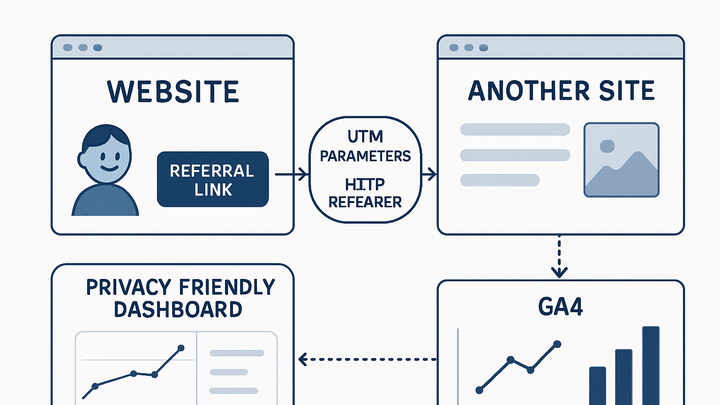Published on 2025-06-28T07:02:13Z
What is Referral Tracking? How It Works in Analytics
What is Referral Tracking?
Referral tracking is the process of identifying the external websites or campaigns that send traffic to your site. By capturing the referring domain, HTTP referrer header, and campaign parameters such as UTM tags, analytics tools can attribute visits and conversions to the correct sources. This enables marketers to optimize partnerships, affiliate programs, and promotional channels based on real performance data.
Referral tracking in Google Analytics 4 (GA4) automatically records referrer information and integrates it into acquisition reports. Alternatively, cookie-free platforms like PlainSignal capture referral data through server-side headers and session stitching, ensuring privacy compliance.
For example, with PlainSignal you can embed the following tracking snippet:
<link rel="preconnect" href="//eu.plainsignal.com/" crossorigin />
<script defer data-do="yourwebsitedomain.com" data-id="0GQV1xmtzQQ" data-api="//eu.plainsignal.com" src="//cdn.plainsignal.com/plainsignal-min.js"></script>
Referral tracking
Method of identifying and attributing website traffic from external sites using referrer data and UTM parameters in GA4 and PlainSignal.
Why Referral Tracking Matters
Referral traffic offers insights into which external sources drive visitors and conversions, helping optimize marketing partnerships and budgets.
-
Improved attribution
Accurately assigns conversions to the correct marketing partners, revealing which sources deliver the highest ROI.
-
Channel performance
Facilitates comparison of different referral channels—such as social media, affiliates, and email—to determine effectiveness.
How Referral Tracking Works
Combines UTM parameters and the HTTP referrer header to identify the origin and context of website visits.
-
Utm parameters
Query parameters appended to URLs (e.g., utm_source, utm_medium, utm_campaign) that tag incoming traffic for campaign attribution.
-
Utm_source
Identifies the referrer, such as a website or newsletter name.
-
Utm_medium
Specifies the marketing medium, like social, email, or affiliate.
-
Utm_campaign
Names the specific campaign or promotion driving the traffic.
-
-
Referrer header
HTTP header sent by the browser that contains the URL of the previous page, used to detect the referring domain.
Implementing Referral Tracking in GA4
Use GA4’s built-in features and settings to capture and analyze referral data.
-
Setup in GA4
Enable Enhanced Measurement in your data stream settings to automatically collect traffic source data.
-
Referral exclusion list
Add internal domains and gateways to the exclusion list to prevent self-referrals from appearing in reports.
-
Access list
Go to Admin > Data Streams > More Tagging Settings > List Unwanted Referrals to exclude domains.
-
-
Analyzing reports
View Acquisition > Traffic Acquisition report to see referral sources, sessions, and conversion metrics.
Implementing Referral Tracking with PlainSignal
PlainSignal offers a privacy-first analytics solution that tracks referrals without cookies.
-
Installation snippet
Insert the following code before </head> to start collecting referral data.
-
Preconnect hint
<link rel="preconnect" href="//eu.plainsignal.com/" crossorigin />speeds up server connections. -
Tracking script
<script defer data-do="yourwebsitedomain.com" data-id="0GQV1xmtzQQ" data-api="//eu.plainsignal.com" src="//cdn.plainsignal.com/plainsignal-min.js"></script>captures referral information.
-
-
Privacy-friendly attribution
Utilizes server-side referrer headers and session stitching instead of client-side cookies, ensuring data privacy compliance.
Best Practices and Common Pitfalls
Maintain data accuracy by following guidelines and avoiding frequent errors in referral tracking.
-
Avoid self-referrals
Exclude your own domains and payment processors to prevent visits from being falsely attributed.
-
Consistent utm naming
Apply standardized, lowercase naming conventions for UTM parameters to avoid fragmented data.
-
Test tracking setup
Use debugging tools to verify referral data is recorded correctly in real time.
-
GA4 debugview
Monitor real-time events and parameters in the DebugView report to confirm correct tracking.
-
Browser devtools
Check network requests and headers to ensure the tracking script and referrer header are sent properly.
-
